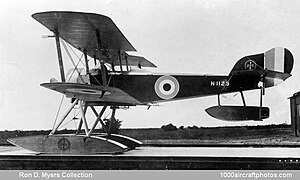Sopwith Baby
| Baby | |
|---|---|
 |
|
| Sopwith Baby in use with the Royal Norwegian Navy Air Service | |
| Role | Single-seat scout and bomber biplane seaplane |
| Manufacturer | Sopwith Aviation Company |
| First flight | September 1915 |
| Introduction | 1915 |
| Status | retired |
| Primary users |
Royal Naval Air Service Aviazione della Regia Marina |
| Number built | 386 |
| Developed from | Sopwith Schneider |
| Variants | Fairey Hamble Baby |
The Sopwith Baby was a British single-seat tractor seaplane used by the Royal Naval Air Service (RNAS) from 1915.
The Baby (also known as the Admiralty 8200 Type) was a development of the two-seat Sopwith Schneider. Although the Schneider had won the Schneider trophy in 1914, the RNAS did not place a formal order until January 1915. Sopwith's initial production version of the Baby differed little from the Schneider Trophy winner.
The Baby utilized a wooden structure with fabric covering. A Lewis Gun was fitted, either above the fuselage firing through the propeller arc without the benefit of synchronization, or over the top wing, firing above it. To meet the more demanding conditions of 1916–18, Further modifications were made on aircraft built by Blackburn Aircraft at Leeds, United Kingdom. A modified variant of the Baby, the Fairey Hamble Baby was built by Fairey and Parnall.
The Royal Naval Air Service ordered 286 Sopwith Babies of which 100 were built by Sopwith at Kingston and 186 by Blackburn Aircraft at Leeds with others for export. License manufacture was also undertaken in Italy by SA Aeronautica Gio Ansaldo of Turin, who built 100 examples for the Italian Aviazione della Regia Marina.
The Baby was used as a shipborne reconnaissance and bomber aircraft operating from seaplane carriers and cruisers, as well as naval trawlers and minelayers. Many Babies were attached to RNAS coastal air stations located in England and Scotland and RNAS stations in Egypt, Greece and Italy.
...
Wikipedia
